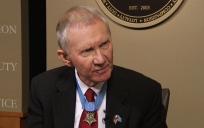
Record date:
Medal of Honor Recipient Patrick H. Brady Interview
For all of the money and development hours that go into best-selling video games, the virtual world still hasn't caught up with what Patrick Brady did with a real-life medevac helicopter in Chu Lai, Vietnam - amazing feats that earned him the nation's highest combat award, the Medal of Honor.
Brady's rescue missions defy imagination. His helicopter flew to crash sites that no other vehicle could reach by land or sky. He flew sideways up mountains and through valleys shrouded in darkness and fog, using faint outlines of trees and streams to orient his craft; he spotted faint skidmarks from the air to make a safe landing in a minefield, and kept his copter in the air with a hole blown in the side. In all, Brady's helicopters were riddled by enemy fire more than 400 times, and never went down. Far greater, though, were the numbers of American, South Vietnamese, and North Vietnamese soldiers he rescued in mission after tireless mission, a medic and a soldier who cared deeply about taking care of people and kept in top physical condition to do it.
Maj. Gen. Patrick H. Brady retired from the Army in 1993. He is the current Chairman of the Citizens Flag Alliance, which lobbies for a constitutional amendment to ban desecration of the American flag, and the former President of the Congressional Medal of Honor Society.
His Citation Reads:
For conspicuous gallantry and intrepidity in action at the risk of his life above and beyond the call of duty, MAJ Brady distinguished himself while serving in the Republic of Vietnam commanding a UH-1H ambulance helicopter, volunteered to rescue wounded men from a site in enemy held territory which was reported to be heavily defended and to be blanketed by fog. To reach the site he descended through heavy fog and smoke and hovered slowly along a valley trail, turning his ship sideward to blow away the fog with the backwash from his rotor blades. Despite the unchallenged, close-range enemy fire, he found the dangerously small site, where he successfully landed and evacuated two badly wounded South Vietnamese soldiers. He was then called to another area completely covered by dense fog where American casualties lay only 50 meters from the enemy. Two aircraft had previously been shot down and others had made unsuccessful attempts to reach this site earlier in the day. With unmatched skill and extraordinary courage, MAJ Brady made four flights to this embattled landing zone and successfully rescued all the wounded. On his third mission of the day MAJ Brady once again landed at a site surrounded by the enemy. The friendly ground force, pinned down by enemy fire, had been unable to reach and secure the landing zone. Although his aircraft had been badly damaged and his controls partially shot away during his initial entry into this area, he returned minutes later and rescued the remaining injured. Shortly thereafter, obtaining a replacement aircraft, MAJ Brady was requested to land in an enemy minefield where a platoon of American soldiers was trapped. A mine detonated near his helicopter, wounding two crewmembers and damaging his ship. In spite of this, he managed to fly six severely injured patients to medical aid. Throughout that day MAJ Brady utilized three helicopters to evacuate a total of 51 seriously wounded men, many of whom would have perished without prompt medical treatment. MAJ Brady's bravery was in the highest traditions of the military service and reflects great credit upon himself and the U.S. Army.










